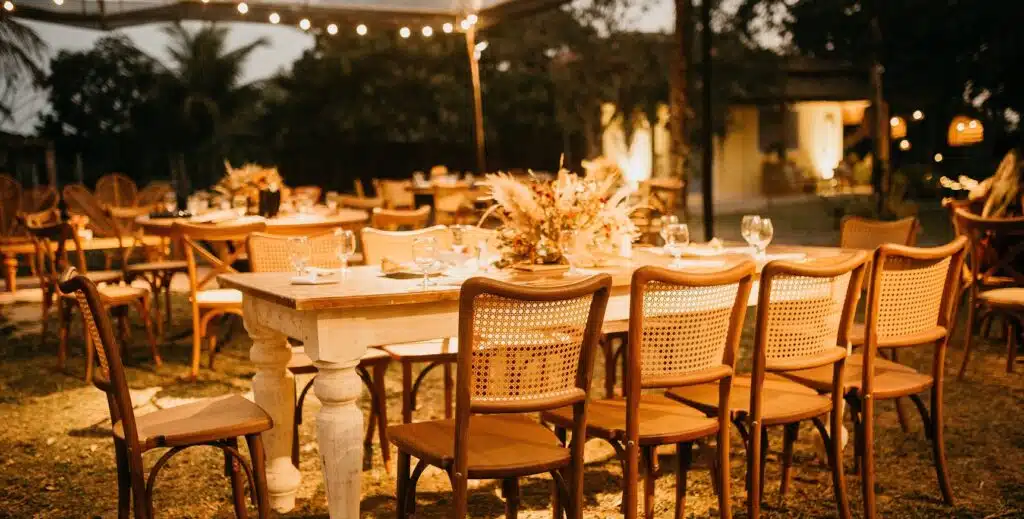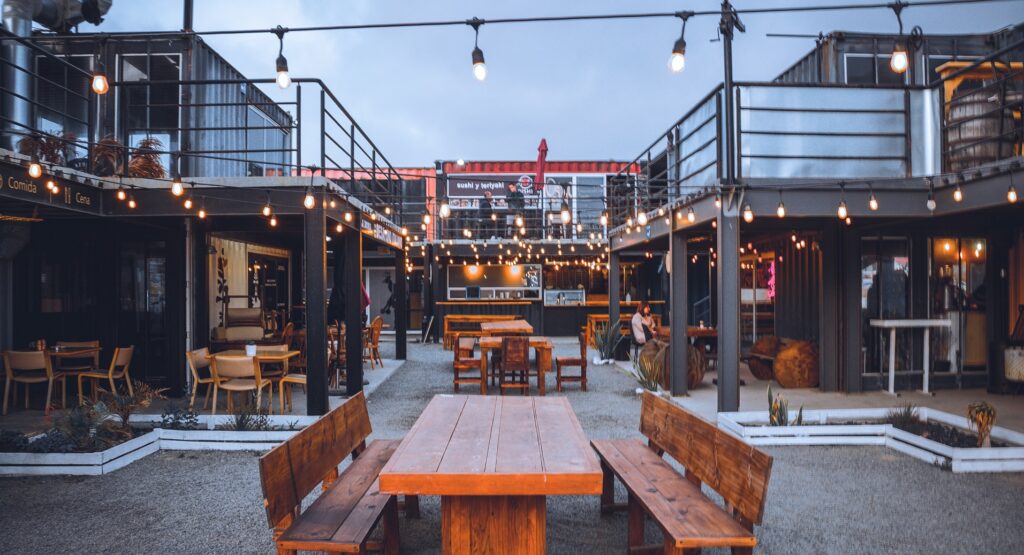Outdoor lighting can make all the difference for your home: curb appeal, a polished look, enhanced safety, and outdoor living spaces you love. But not all outdoor light fixtures are the same; each type has certain uses and benefits. For example, floodlights installed at corners and near entries are great when you need high visibility. They’re not so great when you want to create a welcoming glow for guests or enjoy a quiet drink under twinkling lights. Let’s take a look at the different types of outdoor light fixtures, their components, and which fixtures will work best for the different outdoor areas of your home.
Materials used in outdoor light fixtures
Outdoor light fixtures come in a variety of materials, from plastic to stainless steel. All lighting fixtures will have a variety of materials used in their different components. When we refer to the material for outdoor light fixtures, we’re talking about the main material used for the light cover (or case) and any supports or mounts. High-quality materials will weather better and last longer, so keep that in mind when choosing fixtures.
- Plastic: some plastics are quite durable, but in general you’ll find that plastic is only used as a main component on cheaper light fixtures, like those solar-powered sets you get on the discount rack at the hardware store. If you pick up plastic fixtures, don’t expect to use them for more than a single season.
- Aluminum: aluminum is a lightweight, flexible metal that doesn’t rust (though it will eventually corrode), so it’s ideal for use in outdoor light parts. However, there are different types of aluminum. Some are so thin that they’ll easily get dinged and dented. Look for outdoor light fixtures made with marine-grade aluminum, which is stronger and has a higher resistance to corrosion.
- Stainless steel: a popular choice for modern designs, stainless steel has a clean look which works well for minimal and sleek fixtures. In its natural state, it will reflect the sun, but it’s often powder-coated to both reduce the need for maintenance and provide different finishes to match the home’s decor.
- Brass: brass is an alloy of copper and zinc that holds up well, lasts a long time, and looks great. Since it’s so durable and ages well, you’ll often find that solid brass light fixtures have extended or even lifetime warranties. As brass ages outside, it will slowly develop a natural patina that just adds to its classically beautiful look.
- Copper: copper is not as solid as brass, but it is strong and resists corrosion. It also develops a beautiful patina over time. Some outdoor light fixtures are made of brass coated in copper to provide that durability and the gorgeous aged copper look.
Choose materials that work with your home’s style, and that will last.
Quality matters with outdoor light parts
You probably picked up on this point when reading about materials, but we’ll make sure: quality matters for outdoor light fixtures. Of course, quality matters with any type of lighting. But outdoor lighting fixtures aren’t just hanging pretty in your hallway. They’re exposed to all sorts of weather, changes in humidity, sunshine, freezing temperatures, wind, and so on. It’s a tough life for outdoor lamps and all their parts. So, when you’re choosing that perfect fixture to put over the front door, choose a high-quality product. It’s worth a slightly higher price to have a fixture that lasts longer and looks better. Plus, you’ll find that most of the higher-grade fixtures have lengthy warranties.
Different types of outdoor light fixtures
Now that we’ve covered the different materials, let’s take a quick look at the different types of outdoor light fixtures.
Wall-mounted fixtures
Wall-mounted fixtures are mounted to an exterior wall. They can be flush-mounted, which means they sit flat against the wall. Or they can have an extension, or arm, between the mounting plate and the wall. Wall-mounted fixtures are also called sconces. They’re commonly used beside doors and as accent lights in outdoor living spaces.
Ceiling-mounted fixtures
Ceiling-mounted fixtures range from chandeliers to outdoor ceiling fans to simple, flush-mounted ceiling lights. They’re popular options for porches, patios, and other outdoor structures. Since they require a ceiling, they’re less versatile than other outdoor fixtures.
Spotlights
Spotlights are used in landscape lighting, home uplighting, and as security lights. The type of spotlight determines both how wide the spread of light is and how well it can be angled. A key part of good lighting design is to use the right amount of spotlights, spaced properly, and set at the right angle. Some spotlights have covers that are adjustable, allowing the beam to be narrowed or widened as needed.
Walkway lights
Walkway lights are small fixtures on a support that usually reach about a foot high. They give off a downward beam of light and are most commonly used by pathways and sidewalks. They have a lot of other great uses, too.
String lights
String lights are a great lighting option for creating a relaxed, cozy ambiance in any outdoor living space. Small string lights, also called twinkle lights or holiday lights, have tiny bulbs and can be hung almost anywhere for a magical touch. Bistro lights are another type of string lighting that are very popular. They have larger, Edison-style bulbs and give off that Parisian cafe vibe anywhere you hang them.
Outdoor light fixture parts
Not all outdoor light fixtures have the same parts. There’s variation with different types of fixtures. However, these are the components that are common for outdoor light fixtures:
Wiring
The wiring carries power from your power supply to the bulb so it can produce light. Some cheaper styles of outdoor fixtures use a thin gauge of wiring that can get damaged and corroded easily.
Bulb
Low-voltage LED bulbs are the way to go. They’re energy efficient, last longer, and have a variety of color temperatures to choose from.
Bulb socket
The socket, or holder, connects the bulb to the rest of the fixture.
Cover/case
This is the most visible part of the fixture. The case around the bulb for both protection and to provide a decorative element. The cover can be made of the materials listed above. Styles and finishes vary greatly. Some spotlights have adjustable covers which allow you to control the spread of light from the bulb.
Supporting element
Walkway lights have a small mounting pole as the supporting element. A chandelier might be hung on a chain. Wall sconces often have an arm that provides extension and support.
Mounting element
Typically, the mounting element is a backplate that is attached securely to the wall or ceiling in order to hold the fixture in place.
Hardware
Hardware attaches the fixture to the mounting element and/or supporting elements.
There’s a lot of variation in the different elements and types of fixtures. Bistro lights, for example, don’t have a cover or case at all. For a supporting element, they might be attached to the corner of the house or outdoor structure. Or they can be hung from trees with special mounting hardware that won’t cause damage to the tree. If there are no structures or trees nearby, we cut and install custom support poles so we can create the perfect lighting design for our clients.
If you’re looking for help with the perfect outdoor light fixtures in the St. Louis area, get in touch. We’ll schedule a free consultation to hear about your needs and come up with the best lighting design. Give us a call today!




